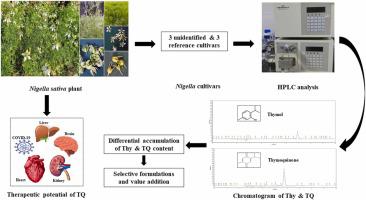当前位置:
X-MOL 学术
›
Ind. Crops Prod.
›
论文详情
Our official English website, www.x-mol.net, welcomes your feedback! (Note: you will need to create a separate account there.)
Tracing metabolic route of thymoquinone biosynthesis in diverse Nigella sativa L. cultivars using RP-HPLC technique
Industrial Crops and Products ( IF 5.6 ) Pub Date : 2024-06-25 , DOI: 10.1016/j.indcrop.2024.118972 Upagya Gyaneshwari , Brijesh Pandey
Industrial Crops and Products ( IF 5.6 ) Pub Date : 2024-06-25 , DOI: 10.1016/j.indcrop.2024.118972 Upagya Gyaneshwari , Brijesh Pandey

|
Although the therapeutic role of has been known for a long time, for optimal utilization of plant parts, the developmental profiling of bioactive constituents and their dependence on germplasm diversity need to be assessed.Different cultivars of (covering 3 samples from northern states of India and 3 reference samples) were taken to explore the relative accumulation of thymol (Thy) and thymoquinone (TQ) in different plant parts, i.e., stem, leaf, bud, flower, fruit, and seeds. Amongst all cultivars, the maximum TQ content was found in the seed (45.3885 ± 0.3616 mg/g fresh weight) of the RS cultivar. Seeds of the AN1 cultivar showed the maximum Thy content (2.7853± 0.3535 mg/g fresh weight). The minimum Thy content was found in leaves of Haryana (0.0009 ± 0 mg/g fresh weight) and leaves from RS showed the minimum TQ content (0.0029 ± 0.0001 mg/g fresh weight). There are indications that mature seeds are the best source for both Thy and TQ, followed by fresh seeds collected from the intact fruit of . . In addition, Thy (precursor) and TQ (product)contentin many plant parts are inversely related to each other, especially in the buds. This indicatedthe interdependence of these two bioactive constituents, but not necessarily in all plant parts. It appears that there might be another functional precursor (in addition to Thy)leading to TQ biosynthesis (speculated to be Carvacrol) in Such relative dominance of bioactive compounds and their precursors may be used for designing formulations and setting biotransformation experiments for further value addition.
中文翻译:

利用 RP-HPLC 技术追踪不同黑种草品种中百里醌生物合成的代谢途径
尽管其治疗作用早已为人所知,但为了最佳利用植物部分,需要评估生物活性成分的发育概况及其对种质多样性的依赖性。不同品种的(涵盖来自印度北部各州的 3 个样本)取3个参考样品)探讨百里酚(Thy)和百里醌(TQ)在植物不同部位(即茎、叶、芽、花、果实和种子)中的相对积累情况。在所有品种中,RS品种的种子中TQ含量最高(45.3885±0.3616mg/g鲜重)。 AN1品种种子的Thy含量最高(2.7853±0.3535mg/g鲜重)。哈里亚纳邦的叶子中 Thy 含量最低(0.0009 ± 0mg/g 鲜重),RS 的叶子中 TQ 含量最低(0.0029 ± 0.0001mg/g 鲜重)。有迹象表明,成熟的种子是 Thy 和 TQ 的最佳来源,其次是从完整果实中收集的新鲜种子。 。此外,许多植物部位中的Thy(前体)和TQ(产物)含量彼此呈负相关,特别是在芽中。这表明这两种生物活性成分相互依赖,但不一定存在于所有植物部分。似乎可能存在另一种功能性前体(除了 Thy 之外)导致 TQ 生物合成(推测是香芹酚)。生物活性化合物及其前体的这种相对优势可用于设计配方和设置生物转化实验以进一步增加价值。
更新日期:2024-06-25
中文翻译:

利用 RP-HPLC 技术追踪不同黑种草品种中百里醌生物合成的代谢途径
尽管其治疗作用早已为人所知,但为了最佳利用植物部分,需要评估生物活性成分的发育概况及其对种质多样性的依赖性。不同品种的(涵盖来自印度北部各州的 3 个样本)取3个参考样品)探讨百里酚(Thy)和百里醌(TQ)在植物不同部位(即茎、叶、芽、花、果实和种子)中的相对积累情况。在所有品种中,RS品种的种子中TQ含量最高(45.3885±0.3616mg/g鲜重)。 AN1品种种子的Thy含量最高(2.7853±0.3535mg/g鲜重)。哈里亚纳邦的叶子中 Thy 含量最低(0.0009 ± 0mg/g 鲜重),RS 的叶子中 TQ 含量最低(0.0029 ± 0.0001mg/g 鲜重)。有迹象表明,成熟的种子是 Thy 和 TQ 的最佳来源,其次是从完整果实中收集的新鲜种子。 。此外,许多植物部位中的Thy(前体)和TQ(产物)含量彼此呈负相关,特别是在芽中。这表明这两种生物活性成分相互依赖,但不一定存在于所有植物部分。似乎可能存在另一种功能性前体(除了 Thy 之外)导致 TQ 生物合成(推测是香芹酚)。生物活性化合物及其前体的这种相对优势可用于设计配方和设置生物转化实验以进一步增加价值。
















































 京公网安备 11010802027423号
京公网安备 11010802027423号